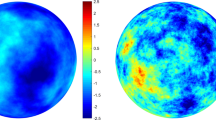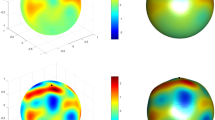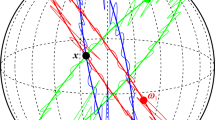Abstract
The Rényi function plays an important role in the analysis of multifractal random fields. For random fields on the sphere, there are three models in the literature where the Rényi function is known explicitly. The theoretical part of the article presents multifractal random fields on the sphere and develops specific models where the Rényi function can be computed explicitly. For all considered models explicit expressions of their multifractal spectrum are obtained. Properties of the models and dependencies of their characteristics on parameters are investigated. Then these results are applied to the Cosmic Microwave Background Radiation data collected from the Planck mission. The main statistical model used to describe these data in the literature is isotropic Gaussian fields. We present numerical multifractality studies and methodology based on simulating random fields, computing the Rényi function and the multifractal spectrum for different scenarios and actual CMB data. The obtained results can also find numerous potential applications for other geoscience, environmental and directional data.








Similar content being viewed by others
Data availability
CMB data from the mission Planck which were used for the analysis purposes are freely available in the NASA/IPAC Infrared Science Archive, see NASA (2020).
Code availability
All numerical studies were conducted by using Maple 2019.0 and R 3.6.3 software, in particular, the R packages ‘rcosmo’ (Fryer et al. 2019, Fryer et al. 2020) and ‘RandomFields’ (Schlather et al. 2019). A reproducible version of the code in this paper is available in the folder “Research materials” from the website https://sites.google.com/site/olenkoandriy/.
References
Abramowitz M, Stegun IA (1948) Handbook of Mathematical Functions with Formulas, Graphs, and Mathematical Tables. Dover Publications, New York
Angulo J, Anh V, Ruiz-Medina M (2008) Multifractality in space-time statistical models. Stoch Environ Res Risk Assess 22:81–86
Angulo J, Esquivel FJ (2015) Multifractal dimensional dependence assessment based on Tsallis mutual information. Entropy 17:5382–5401
Anh V, Leonenko N, Olenko A (2015) On the rate of convergence to Rosenblatt-type distribution. J Math Anal Appl 425(1):111–132
Anh V, Leonenko N, Olenko A, Vaskovych V (2019) On rate of convergence in non-central limit theorems. Bernoulli 25(4A):2920–2948
Anh V, Broadbridge P, Olenko A, Wang YG (2018) On approximation for fractional stochastic partial differential equations on the sphere. Stoch Environ Res Risk Assess 32(9):2585–2603
Anh V, Leonenko N, Shieh NR (2008) Multifractality of products of geometric Ornstein–Uhlenbeck-type processes. Adv Appl Probab 40(4):1129–1156
Broadbridge P, Kolesnik AD, Leonenko N, Olenko A (2019) Random spherical hyperbolic diffusion. J Stat Phys 177(5):889–916
Broadbridge P, Kolesnik AD, Leonenko N, Olenko A, Omari D (2020) Spherically restricted random hyperbolic diffusion. Entropy 22(2):217
Christakos G (2017) Spatiotemporal Random Fields: Theory and Applications. Elsevier, Netherlands
Denisov D, Leonenko N (2016) Limit theorems for multifractal products of geometric stationary processes. Bernoulli 22(4):2579–2608
Emery X, Porcu E (2019) Simulating isotropic vector-valued Gaussian random fields on the sphere through finite harmonics approximations. Stoch Environ Res Risk Assess 33:1659–1667
Emery X, Porcu E, Bissiri PG (2019) A semiparametric class of axially symmetric random fields on the sphere. Stoch Environ Res Risk Assess 33:1863–1874
Falconer KJ (1994) The multifractal spectrum of statistically self-similar measures. J Theor Probab 7(3):681–702
Fryer D, Li M, Olenko A (2020) Rcosmo: R package for analysis of spherical. HEALPix and cosmological data. R Journal 12(1):206–225
Fryer, D., Olenko, A.: Spherical data handling and analysis with R package rcosmo. In: H. Nguyen (ed.) Statistics and Data Science. RSSDS 2019, pp. 211–225. Springer, Singapore (2019)
Fryer, D., Olenko, A., Li, M., Wang, Y.G.: rcosmo: Cosmic Microwave Background Data Analysis (2019). https://CRAN.R-project.org/package=rcosmo. R package version 1.1.0
Gneiting T (2013) Strictly and non-strictly positive definite functions on spheres. Bernoulli 19(4):1327–1349
Grahovac D, Leonenko N (2014) Detecting multifractal stochastic processes under heavy-tailed effects. Chaos, Solitons Fractals 65:78–89
Harte D (2001) Multifractals: Theory and Applications. Chapman and Hall/CRC, Boca Raton
Hill JC (2018) Foreground biases on primordial non-Gaussianity measurements from the CMB temperature bispectrum: Implications for Planck and beyond. Phys Rev D 98(8):083542
Jaffard S (1999) The multifractal nature of Lévy processes. Probab Theory Relat Fields 114(2):207–227
Janson S (1997) Gaussian Hilbert Spaces. Cambridge University Press, Cambridge
Jeong J, Jun M, Genton MG (2017) Spherical process models for global spatial statistics. Statist Sci 32(4):501–513
Kahane JP (1987) Positive martingales and random measures. Chinese Ann Math B 8(1):1–12
Kevork, A., Graeme, A., Peter, A., Zeeshan, A., Steven W., A., David, A., et al.: CMB-S4 Science Case, Reference Design, and Project Plan (2019). https://arxiv.org/abs/1907.04473
Kogut A, Banday A, Bennett C, Górski K, Hinshaw G, Smoot G et al (1996) Tests for non-Gaussian statistics in the DMR four-year sky maps. Astrophys J Lett 464(1):L29–L33
Lang A, Schwab C (2015) Isotropic Gaussian random fields on the sphere: Regularity, fast simulation and stochastic partial differential equations. Ann Appl Probab 25(6):3047–3094
Leonenko N (1999) Limit Theorems for Random Fields with Singular Spectrum. Springer, Dordrecht
Leonenko N, Shieh NR (2013) Rényi function for multifractal random fields. Fractals 21(2):1350009
Loéve M (1977) Probability Theory. Springer, New York
Malyarenko A (2012) Invariant Random Fields on Spaces with a Group Action. Springer-Verlag, Berlin
Mannersalo P, Norros I, Riedi RH (2002) Multifractal products of stochastic processes: construction and some basic properties. Adv Appl Probab 34(4):888–903
Marinucci D (2004) Testing for non-Gaussianity on cosmic microwave background radiation: A review. Stat Sci 19(2):294–307
Marinucci D, Peccati G (2011) Random Fields on the Sphere: Representation, Limit Theorems and Cosmological Applications. Cambridge University Press, New York
Minkov M, Pinkwart M, Schupp P (2019) Entropy methods for CMB analysis of anisotropy and non-Gaussianity. Phys Rev D 99(10):103501
Molchan G (1996) Scaling exponents and multifractal dimensions for independent random cascades. Commun Math Phys 179(3):681–702
NASA/IPAC infrared science archive: https://irsa.ipac.caltech.edu/data/Planck/release_2/all-sky-maps/maps/component-maps/cmb/ (2019). Accessed 2 October 2020
Novikov D, Schmalzing J, Mukhanov V (2000) On non-gaussianity in the cosmic microwave background. Astron Astrophys 364(1)
Peccati G, Taqqu MS (2011) Wiener Chaos: Moments, Cumulants and Diagrams: A Survey with Computer Implementation. Springer-Verlag, Mailand
Planck and the cosmic microwave background: https://www.esa.int/Science_Exploration/Space_Science/Planck/Planck_and_the_cosmic_microwave_background (2020). Accessed 2 October 2020
Porcu E, Alegria A, Furrer R (2018) Modeling temporally evolving and spatially globally dependent data. Int Stat Rev 86(2):344–377
Riedi RH (2002) Multifractal processes. In: Doukhan P, Oppenheim G, Taqqu M (eds) Theory and Applications of Long-Range Dependence. Birkhäuser, Basel, pp 625–716
Schlather, M., Malinowski, A., Oesting, M., Boecker, D., Strokorb, K., Engelke, S., et al.: RandomFields: Simulation and Analysis of Random Fields (2019). https://cran.r-project.org/package=RandomFields. R package version 3.3.6
Starck JL, Aghanim N, Forni O (2004) Detection and discrimination of cosmological non-gaussian signatures by multi-scale methods. Astron Astrophys 416(1):9–17
The Cosmic Microwave Background: http://planck.cf.ac.uk/science/cmb (2020). Accessed 2 October 2020
Acknowledgements
This research was partially supported under the Australian Research Council’s Discovery Projects funding scheme (Project Number DP160101366). The authors are also grateful to the anonymous referees for their suggestions that helped to improve the style of the paper. We also would like to thank Professor P. Broadbridge for numerous discussions of CMB and underlying physics models.
Author information
Authors and Affiliations
Contributions
All the authors equally contributed to the paper.
Corresponding author
Ethics declarations
Conflict of interest
The authors declare that they have no known competing interests for the results reported in this paper.
Additional information
Publisher's Note
Springer Nature remains neutral with regard to jurisdictional claims in published maps and institutional affiliations.
Appendix A Proofs
Appendix A Proofs
Proof
(Theorem 5.1) By Remark 4.1, from the weak convergence of the measures \(\mu _k\) to \(\mu \) and the assumption of exponential boundedness of the covariance function of the mother field, it follows that
By the Lyapunov’s inequality, see (Loéve 1977, p.162),
Therefore, to guarantee \(E\mu ^q(B^3)< +\infty , \, q \in [1,2],\) it is sufficient to provide such b and \(\sigma ^2_{\varLambda }\) that
By (4), the non-negativity of \(\varLambda _{k}(y)\) and independence of \(\varLambda ^{(i)}\) it holds
From the inequality \(1+a \le e^a\), it follows that
Introducing the new variables \(z=y\), \(\tilde{z} = y-\tilde{y},\) one obtains
where \(B^3-B^3 = \{\tilde{z}: \tilde{z}=y-\tilde{y}, \, y, \, \tilde{y} \in B^3 \}.\)
Hence, by using the spherical change of variables,
As the exponent \(e^{\sigma ^2_{\varLambda }C e^{-r b^i}}\) is a decreasing function of r, selecting \(n(r) = \max (0, -[\log _b(r)]),\) \(r>0,\) we obtain
Notice that
Therefore,
The integral is finite if \(2-\frac{\sigma ^2_{\varLambda }C}{\ln {(b)}} > -1,\) i.e. \(b> e^{\frac{\sigma ^2_{\varLambda }C}{3}}\). \(\square \)
Proof
(Theorem 7.1) By the definition of Model 4 it follows that
To compute the covariance, we used the property
where \(H_k(u), \, k \ge 0, \, u \in {\mathbb {R}},\) are the Hermite polynomials, see Peccati and Taqqu (2011). For \(k=2\), the Hermite polynomial of order 2 is \(H_2(u) = u^2 -1.\)
Thus, Model 4 satisfies Conditions 1 and 2.
Note that the condition \(|\rho _{\varLambda }(r)| \le Ce^{-\gamma r}, \, r>0, \, \gamma >0,\) is equivalent to
So, if (25) is satisfied, then one can apply Theorems 4.1 and 4.2 and the Rényi function of the limit measure equals to
Finally, noting that for \(p > -1\) and \(Z \sim N(\mu , \sigma ^2)\)
finalises the proof. \(\square \)
Proof
(Example 7.1) By Remark 5.1, it is enough to check that
Notice, that by Wick’s theorem
where the sum is over all parings p of \(\{1,1,2,2,3,3,4,4\},\) which are distinct ways of partitioning \(\{1,1,2,2,3,3,4,4\}\) into pairs (i, j). The product in (27) is over all pairs contained in p, see Janson (1997).
Notice that for the pairing \(p^{*}=\{(1,1),(2,2),(3,3),(4,4)\}.\)
In all other cases of pairing there is at least one pair \((j, \tilde{j})\) such that \(j \ne \tilde{j}\). Therefore, the expectation \(E(\prod _{j=1}^4 Y^2(y_j b^i))\) equals
As, \(1+a < e^a\), it can be estimated by
As at least for one pairing \((j, \tilde{j}) \in p \ne p^{*}\) it holds that \(j \ne \tilde{j},\) then one can use the upper bound
and the approach from the proof of Theorem 5.1.
Namely,
Hence,
where the last inequality follows from the generalized Hölder’s inequality
with \(\sum _{k=1}^{K}{p_k}^{-1}=1\). In our case \(K=6\) is the number of different j and \(\tilde{j}\) satisfying \(1 \le j \le \tilde{j} \le 4.\)
Finally, similar to the proof of Theorem 5.1, from equation (18) we obtain the condition \(b > e^{{\frac{6 {(\max (\sigma _{\varLambda }C, 1))}^4}{3}}}.\) \(\square \)
Proof
(Theorem 7.2) It follows from (26) that
To compute the covariance function we use (24) and the following Hermite expansion (Abramowitz and Stegun 1948, page 775)
Therefore,
where \(\tilde{Y}(x) = Y(x)/\left( \frac{\sqrt{\pi }}{2^k \varGamma (k+\frac{1}{2})}\right) ^{1/{2k}}\) is a zero-mean unit variance Gaussian HIRF with the covariance function
Notice, that for \(i=k\) in (28) by the Legendre duplication formula
Hence,
Therefore, if \(|{\tilde{\rho }}(r)| \le C^{'}e^{-\gamma ^{'}r}, \, r>0,\, \gamma ^{'}>0,\) then the covariance function of Model 5 satisfies the condition \(|\rho _{\varLambda }(r)| \le Ce^{-\gamma r}, r>0, \, \gamma >0,\) and the Rényi function equals
\(\square \)
Proof
(Theorem 7.3) By properties of the chi-square distribution, it follows that
Notice that if \(Y(x) = \frac{1}{2}(Z_1^2(x)+\ldots +Z_k^2(x)), \, x \in {{\mathbb {R}}}^3,\) where \(Z_i(x),\) \(i=1,\ldots ,k,\) are independent zero-mean unit variance components of k-dimensional vector Gaussian HIRF with a covariance function \(\rho _Z(r), \, r \ge 0\) of each component, then
Therefore, Model 6 satisfies Conditions 1 and 2 and \(|\rho _\varLambda (r)| \le Ce^{-\gamma r}, \, r>0\), \(\gamma >0\), if \(|\rho _{Y}(r)| \le C'e^{-\gamma ^{'}r}\) or \(|\rho _{Z}(r)| \le C'e^{-\gamma ^{'}r}, \, r \ge 0, \gamma ^{'}>0.\)
Then, the corresponding Rényi function is given by (20). \(\square \)
Rights and permissions
About this article
Cite this article
Leonenko, N., Nanayakkara, R. & Olenko, A. Analysis of spherical monofractal and multifractal random fields. Stoch Environ Res Risk Assess 35, 681–701 (2021). https://doi.org/10.1007/s00477-020-01911-z
Accepted:
Published:
Issue Date:
DOI: https://doi.org/10.1007/s00477-020-01911-z




